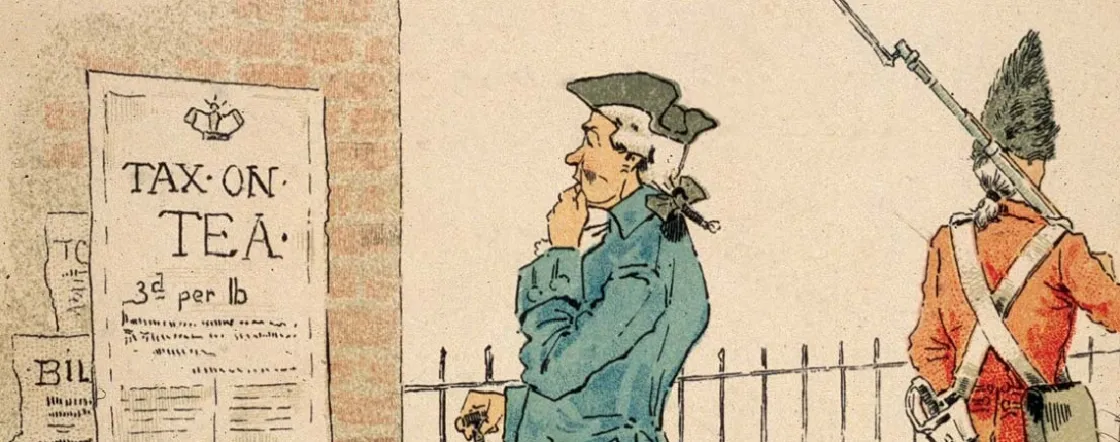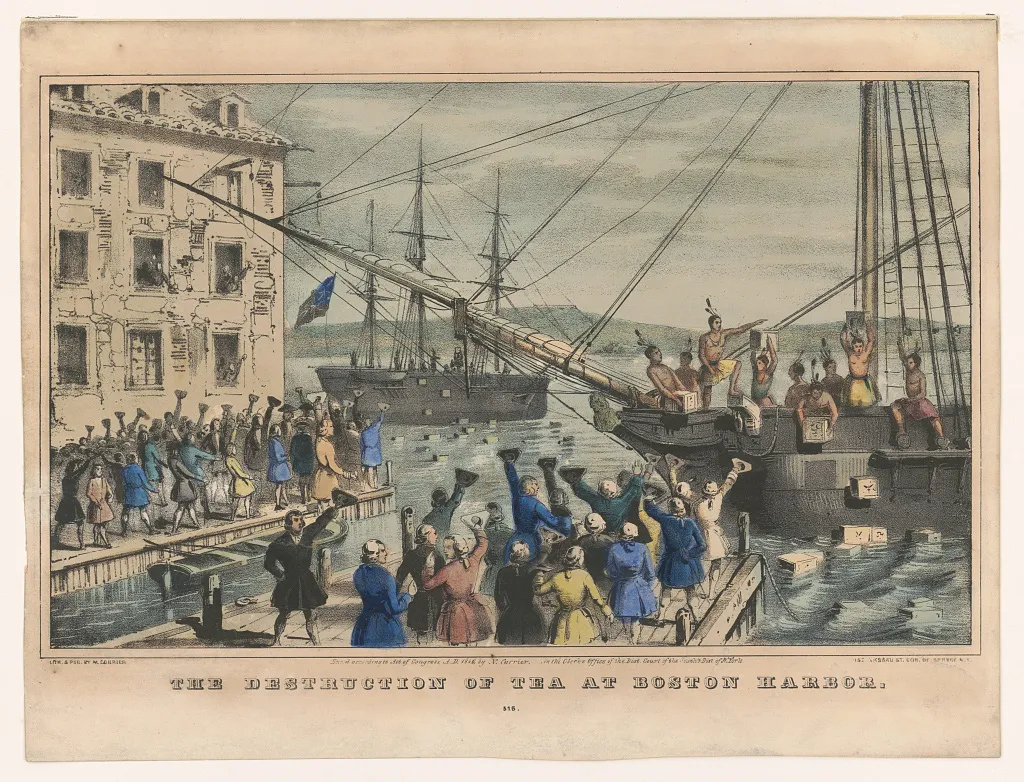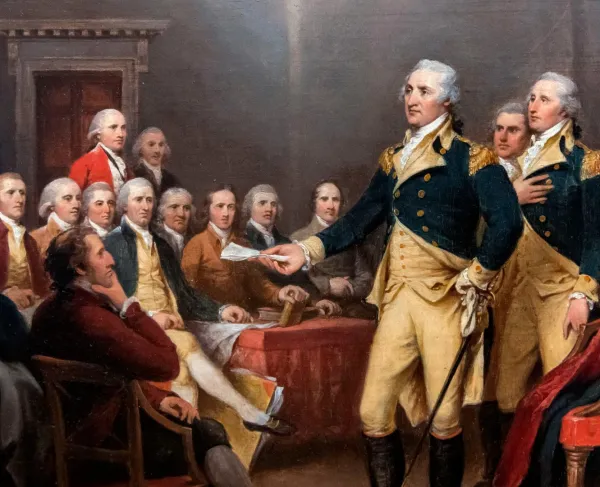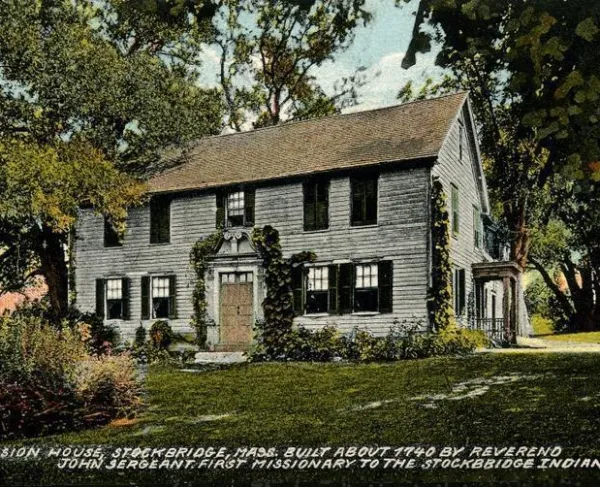
“Boston Tea Party;” by W.W. Cooper. Engraving in The History of North America, 1789.
It is one of the most iconic scenes in the American epoch—defiant colonists dumping crates of tea into Boston Harbor. The Boston Tea Party is known as a central event in the American Revolution. But, it was simply the culmination of a series of events which led the thirteen American colonies closer to independence.
In 1763, Great Britain won the French and Indian War after nine long years. However, British victory came with a hefty price. Parliament began to levy taxes on the North American colonies to pay for the debts incurred by the war. The colonists, who until now had largely maintained the prerogative of self-government, did not take kindly to Parliament’s sudden interest in taxing the colonies. As animosity grew, Boston became a hotbed for revolutionary activity and anti-British sentiment. Parliament passed the Townshend Acts in 1767, which levied a new series of taxes, to repress such activity. Instead of silencing dissent, the Townshend Acts only reinvigorated it. In March 1770, violence broke out in the colonies when British troops fired on an angry mob in the Boston Massacre.
That same year, Parliament rescinded the Townshend Acts but kept the tax on tea. British officials felt they could not forgo a tax on the most popular libation in eighteenth century America. However, boycotts on tea persisted throughout the colonies. Some Bostonians illegally smuggled Dutch tea to dodge the tax. As a result, the East India Company began to experience a financial crisis. Boycotts and smuggling left the company with millions of pounds of surplus tea and threatened to bankrupt it.

Great Britain introduced the Tea Act on May 10, 1773 to reassert itself as the governing authority of the American colonies and spare the East India Company from financial ruin. The Tea Act allowed the company to reduce costs by selling its product directly to colonists, eliminating middlemen who purchased the tea at auction in London. Company officials appointed consignees—or agents—to receive and sell the tea in cities like Boston, Philadelphia, and Charleston. The Tea Act outraged colonists. While the legislation actually reduced the price of imported tea, protestors feared the Tea Act could set a dangerous precedent of Great Britain and the East India Company’s authority over the colonies. Dissenters like Samuel Adams continued to invoke “no taxation without representation,” while others like John Hancock continued to smuggle tea into the colonies. The act also put many tea smugglers and legitimate importers out of business.
Colonial newspapers widely reported the schedule of the first shipment of tea. Seven ships departed for the colonies, four of which bound for Boston. In every colony except Massachusetts, protestors persuaded the tea consignees to resign and thereby forced the tea ships back to England. Massachusetts Governor Thomas Hutchinson was eager to prevent that from happening in Boston, though. When the tea ship Dartmouth finally laid anchor in Boston Harbor in late November 1773, thousands of people descended on the Old South Meeting House on the corner of Milk Street. Led by Samuel Adams and the Sons of Liberty, the people passed a resolution to compel Dartmouth’s captain to return the tea to England and appointed 25 men to keep watch over the wharf to prevent the consignees from unloading the tea. Meanwhile, two more tea ships, Eleanor and Beaver, arrived in Boston Harbor. Hutchinson rebuked the colonists’ demands and ordered the ships to remain docked at Griffin’s Wharf. On December 16, 1773, the day before Dartmouth’s tax deadline, another crowd of thousands gathered at the Old South Meeting House. After receiving word that Governor Hutchinson again refused to allow the ships to leave, the assembly voted to prevent anyone from unloading or using the tea. The people poured out of the meeting house while Samuel Adams desperately tried to restore order.

Later that evening, 30 to 130 men—most of whom belonged to the Sons of Liberty—boarded the three tea ships. Some disguised themselves as Mohawk warriors to conceal their identities. They pried open the 342 chests with axes and dumped the tea overboard into the water. Contemporaneous depictions of the Boston Tea Party portray the Sons of Liberty as an unruly band of rebels who stormed the ships dressed as Native Americans. But according to historical accounts, the Tea Party was an efficient, concerted effort. Each participant fulfilled a specific role. The men on the deck of the ships smashed the chests open while others stood at the railing to heave the chests overboard. A small contingent of men stood watch to prevent anyone from interfering with their mission. They also ensured no one from their own ranks stole the tea or destroyed additional property. In fact, the rebels harmed no other property or people besides the tea. When some of the men allegedly broke a padlock belonging to the captain of one of the ships, the Patriots returned the next day to replace it.
The Boston Tea Party sparked controversy almost immediately. When the sun rose on December 17 to reveal 342 crates of tea floating in the harbor, Governor Thomas Hutchinson condemned it as an act of treason. Though his role in the event is ambiguous, Samuel Adams worked tirelessly to publicize the Tea Party. He ardently promoted it as an act of defense against British taxation and a last resort to save colonial rights. His cousin John Adams praised the Tea Party as a brave “exertion of popular power.” Other colonial leaders like Benjamin Franklin and George Washington disapproved. Franklin felt the interlopers should compensate the East India Company for the damaged tea, while Washington believed the Tea Party to be a flagrant overstep by the Sons of Liberty. Prime Minister Lord North felt Great Britain should respond with a heavy hand. "Whatever may be the consequence,” he reportedly said, “we must risk something; if we do not, all is over.” Lord North’s determination to punish the colonies for the Boston Tea Party resulted in Parliament’s passage of the Coercive Acts, known colloquially throughout America as the Intolerable Acts. Parliament specifically aimed the legislation at New England by closing Boston Harbor, curtailing free elections in Massachusetts, removed colonial judicial authority to Britain, and effectively instituted martial law.
While the Coercive Acts applied almost exclusively to Massachusetts, people across the thirteen colonies feared that Great Britain could violate their colonial charters as well. Moreover, the Quartering Act required all colonies to quarter British troops upon demand. In response to Boston's affliction, colonists across America united in their opposition of the Coercive Acts. In September 1774, delegates from twelve of the thirteen colonies convened in Philadelphia for the First Continental Congress to determine their reaction to Parliament’s punitive measures. The delegates adopted the Suffolk Resolves, which listed the colonies’ grievances against Great Britain, called for a boycott of British goods, and promoted an organized militia for each colony. The last of which helped ignite the Revolutionary War six months later at the Battles of Lexington and Concord. In 1778, as the Continental Army struggled against the British, Parliament repealed the Tea Act in a vain attempt at reconciliation. However, the fledgling United States rejected their attempt at restoring peace. Following the war, colonists regarded tea drinking as unpatriotic. As a result, the Boston Tea Party helped shift cultural attitudes to promote coffee as the preferred drink among Americans and move the American colonies one step closer to war with Great Britain.
Further Reading
- Defiance of the Patriots: The Boston Tea Party and the Making of America By Benjamin L. Carp


